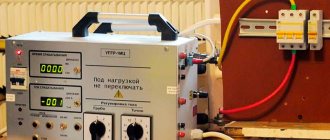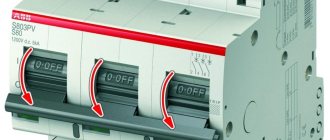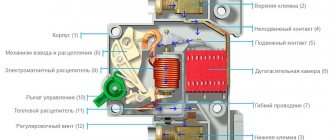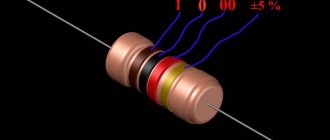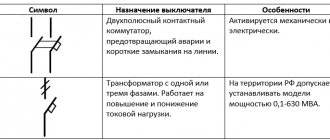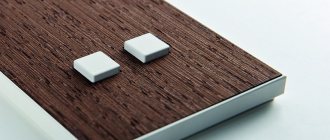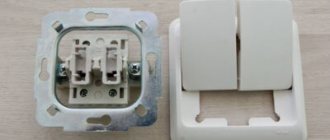Current ratings of circuit breakers
Circuit breakers are devices that protect electrical networks from overload, stray currents, and short circuits. Because they are reliable and easy to use, they are used throughout the household electrical system.
What are denominations
Since all electrical appliances consume different power, their operating current is not the same. Therefore, the automatic protective switch is selected according to the rating.
Circuit breakers are needed in every network
Note! Powerful industrial equipment consumes many amperes, so they have their own indicators.
Criterias of choice
Each electrical network, intra-house or intra-apartment, is individual and has its own characteristics. There are no standard solutions for installing circuit breakers. When choosing a device, it is important to take into account all selection criteria, otherwise an emergency situation may be created.
The principle of indoor wiring
Schematic diagram of electrical wiring in an apartment using a loop.
Internal electrical cables have a branched structure called a graph without cycles. Thanks to this design principle, it is possible to equip all types of circuits with protective functions.
This approach made it possible to increase the stability of the entire system in the event of an emergency, and also simplifies the process of eliminating a breakdown. The load is also distributed evenly.
Total power of electrical appliances
The maximum possible and permissible load on the circuit is observed when all electrical appliances in the apartment are turned on simultaneously. To calculate this indicator, it is enough to simply sum up the total electricity consumed per unit of time.
There are lines for which simultaneous operation of all devices is not possible. Sometimes houses are specially equipped with systems that block the operation of powerful devices.
Selection of core cross-section
Table for selecting the cross-section of electrical wiring conductors
Before installing the power electrical cable from the distribution panel, it is necessary to calculate the power of all electrical appliances. The cross-sectional area of any branch is selected according to the calculation table, taking into account the wiring material, for example, copper and aluminum.
Manufacturers of electrical cables provide the most detailed reference materials with their products. If for some reason the information is missing, you need to refer to the data from the reference book called “Rules for the construction of electrical equipment.”
Sometimes, in order to protect themselves, consumers choose not the minimum permissible cross-sectional area, but with a small margin. This is justified for the following reasons:
- Start of operation of electrical appliances with powerful electric motors, which gives strong starting currents. This process is accompanied by a strong voltage drop, which can lead to serious damage to the electronics of washing machines, air conditioners, etc. The thicker the conductive cable, the smaller the voltage surges will be.
- Long-term operation of a thick cable, which is periodically subjected to maximum permissible loads. Re-wiring an apartment is a troublesome task, especially if the rooms have already undergone high-quality renovations.
- High bandwidth allows you to connect new electrical devices to network branches. For example, you can install an electric oven or freezer in the kitchen.
Current ratings of circuit breakers, subject to all installation, maintenance and operation rules, significantly extend the service life of household appliances and other electrical appliances.
What is the standard line of current circuit breakers?
According to the PUE, each device has an inscription that indicates the nominal value of electrical energy. To get this information, you just need to look at the device's body. It has a letter and a number on it. In total, three letters are usually used for marking - B, C and D. The numbers indicate the amount of charge. The letter shows the time characteristic or period for which the device operates.
Equipment marking
Devices with the first two letters are used for home use. In industry, protective devices D are needed. More powerful units, designated by the letters L, Z and K, are also used. Their rated values are higher than in household, apartment devices.
The standard line includes mini circuit breakers, air circuit breakers, enclosed circuit breakers, residual current circuit breakers and residual current circuit breakers.
Note! The marking also indicates the series, operating voltage, poles and breaking capacity.
How many kilowatts do you need for your home? Electricity consumption table
Our modern society cannot imagine its life without electricity. It is firmly rooted in the daily and industrial life of a person in the twenty-first century.
Electricity is used not only to illuminate streets, residential buildings and other premises. Today, electricity is needed to power the telephone, computer, TV and many other household appliances in our homes, which make the life of a modern person much easier.
Many home owners use electricity for heating, although this is not the cheapest type of heating, it is quite reliable and easy to use.
Like people in the past, modern society cannot exist without electricity. Every year, scientists are developing new technologies that require power. Of course, today electric current is used more widely than before. But after several decades, its consumption will increase several times. So, for example, if 10 years ago 1.5 - 2 kW of electricity was enough for a house or apartment, today this figure has increased to 15 kW, almost 10 times.
Let's try to figure out how many kilowatts a home currently needs.
Indicators of rated current on circuit breakers
In mini-models, the standard ratings of machines are 25-32 A, since they have minimal functionality. They are priced at low cost and cannot be configured manually. Air circuit breakers are large in size, have an open, non-sealed casing and have an increased rated power of 400 A. Closed switches are used for power consumers. They have a closed, hermetically sealed housing and relatively small dimensions. They work with networks up to 3.2 kA. They can be used in extreme humid climates.
For your information! RCDs are the most popular protectors of household electrical networks. They protect apartment electrical wiring and residents from electric shock. They have a rated current of 10 A. Like a number of other devices, RCDs can be single-phase, two-phase and three-phase.
Difavtomat is a hybrid device that has the properties of an RCD. It protects the wiring and provides overload protection. Its rated current value is 6-63 A.
Deciding on the denomination
Actually, from the functions of the circuit breaker, the rule for determining the rating of the circuit breaker follows: it must operate until the current exceeds the capabilities of the wiring. This means that the current rating of the machine must be less than the maximum current that the wiring can withstand.
For each line you need to choose the right circuit breaker
Based on this, the algorithm for selecting a circuit breaker is simple:
- Calculate the wiring cross-section for a specific area.
- See what maximum current this cable can withstand (see the table).
- Next, from all the ratings of the circuit breakers, we select the nearest smaller one. The ratings of the machines are tied to the permissible long-term load currents for a particular cable - they have a slightly lower rating (see the table). The list of denominations looks like this: 16 A, 25 A, 32 A, 40 A, 63 A. From this list you choose the appropriate one. There are smaller values, but they are practically not used anymore - we have too many electrical appliances and they have considerable power.
The algorithm is very simple, but it works flawlessly. To make it clearer, let's look at an example. Below is a table that shows the maximum permissible current for conductors that are used when laying wiring in a house and apartment. Recommendations regarding the use of machines are also given there. They are given in the column “Nominal current of the circuit breaker”. This is where we look for the ratings - it is slightly less than the maximum permissible for the wiring to work normally.
Cross section of copper wires
Permissible continuous load current
Maximum load power for single-phase network 220 V
Rated current of circuit breaker
In the table we find the selected wire cross-section for this line. Suppose we need to lay a cable with a cross-section of 2.5 mm 2 (the most common when laying to medium-power devices). A conductor with this cross-section can withstand a current of 27 A, and the recommended rating of the machine is 16 A.
How will the circuit work then? As long as the current does not exceed 25 A, the machine does not turn off, everything works as normal - the conductor heats up, but not to critical values. When the load current begins to increase and exceeds 25 A, the machine does not turn off for some time - perhaps these are starting currents and they are short-lived. It turns off if the current exceeds 25 A by 13% for a sufficiently long time. In this case, if it reaches 28.25 A. Then the power supply will work and de-energize the branch, since this current already poses a threat to the conductor and its insulation.
Power calculation
Is it possible to choose a machine based on load power? If only one device is connected to the power line (usually large household appliances with high power consumption), then it is permissible to make a calculation based on the power of this equipment. You can also choose an introductory machine based on power, which is installed at the entrance to a house or apartment.
If we are looking for the rating of the input circuit breaker, we need to add up the power of all devices that will be connected to the home network. Then the found total power is substituted into the formula, and the operating current for this load is found.
Formula for calculating current from total power
After we have found the current, select the nominal value. It may be either slightly more or slightly less than the found value. The main thing is that its shutdown current does not exceed the maximum permissible current for this wiring.
When can you use this method? If the wiring is laid with a large margin (this is not bad, by the way). Then, in order to save money, you can automatically install switches corresponding to the load, and not the cross-section of the conductors
But once again we draw your attention to the fact that the long-term permissible current for the load must be greater than the maximum current of the circuit breaker. Only then will the choice of circuit breaker be correct
Where and how are circuit breakers used?
Automatic circuit breakers are designed to protect electrical networks from overloads and short circuit currents. Due to their reliability and ease of connection, they are widely used in household electrical networks.
Automatic circuit protectors
Automatic machines are present in almost every apartment electrical panel. They are no less often found in protection panels for industrial equipment, electric motors and various mobile installations.
Automatic switch - calculation of rating
After determining the cross-section of the conductor that can function without consequences with the total power of the devices connected to the network, you can begin to calculate the nominal values for the machine. Calculations will be carried out according to the current strength. For such calculations, it is enough to use a simple formula known from the physics course taught at school:
Designations:
- I – nominal current;
- P – total power of devices;
- U – voltage.
By substituting the initial values into the formula, we obtain the corresponding indicator for the protective device. Below is a table that makes it easier to find the optimal value for such switches.
Table of machines by power and current Source forca.ru
Rated current of the machine
The power consumption of different electrical appliances can vary thousands of times. Accordingly, the operating current is also different. For example, an ordinary apartment in a residential building consumes up to 16-32 A. Therefore, the apartment network circuit breaker is selected for a similar rating. High-power industrial furnaces can draw hundreds of amps from the power grid. Accordingly, they require a machine with a higher denomination.
Circuit breaker ratings
Possibility of derating the machine
Quite often, electricity consumers install machines in communications that have a lower rating compared to the capacity of the cable in the network. In this way, an attempt is made to create a certain reserve for the automation to operate. However, lowering the rating is justified only if the total power of the devices connected to the network is significantly lower than the cable’s ability to withstand the load.
If, after installing electrical communications, some of the planned devices were removed from the connection diagram, in order to increase safety, you can lower the rating of the machines. This achieves increased sensitivity of the automation and faster response to peak loads.
For example, the motor jammed in a washing machine. In such a situation, a short circuit does not occur, and the automation does not turn off the power to the network. A more sensitive switch will have time to react and prevent melting of the winding in the electric motor.
Copper conductors of various sections Source mposolution.com
Marking of the machine
According to the PUE, each protection device must have an inscription indicating the value of the rated current. To find out the value of the machine, just look at its body. These protection devices use standard markings consisting of one letter (B, C or D) and a number.
The letter indicates the time characteristic. It is also called response time. This parameter will be discussed below. The number indicates the rated current of the device. For example:
- C25 - time characteristic C, rated current 25 A;
- B32 - characteristic B, 32 A.
In everyday life, switches with time characteristics B and C are usually used. In industry, protective devices from the L, Z and K series are found.
Additional Information. The marking also contains other information about the device. For example, series number, rated operating voltage, breaking capacity and number of poles.
Calculation of machine denominations
Based on the fact that the cable cross-section and the maximum load are closely interrelated with each other, knowing at least one parameter, you can calculate the rest without much effort. For convenience, it is recommended to use the selection table for connection and power.
| Rated current | Conductor cross-section | Voltage | |
| 380 V | 220 V | ||
| 1 A | 0.5 mm.sq. | — | 2.4 kW |
| 15 A | 0.75 mm.sq. | — | 3.3 kW |
| 17 A | 1 mm.sq. | 11 kW | 3.7 kW |
| 23 A | 1.5 mm.sq. | 15 kW | 5 kW |
| 30 A | 2.5 mm.sq. | 19 kW | 6.6 kW |
| 41 A | 4 mm.sq. | 26 kW | 9 kW |
Time characteristics of circuit breakers
There are 2 types of releases used in circuit breakers:
- Electromagnetic. Has instant response. If the current of the electromagnetic release is exceeded, the protection device is switched off without any time delay. This unit triggers the machine during a short circuit.
- Thermal release. It works after a while. Used for overload protection. Moreover, the more the permissible power of the consumer is exceeded, the faster the protection will work.
Calculation
How to calculate the rated current of a circuit breaker? Everything is quite simple. Let's look at this calculation using the example of a socket group where an electric kettle with a power of 1.5 kW, a refrigerator with a power of 400 W and a dishwasher with a power of 2.5 kW are connected.
First of all, it is necessary to determine the total power of consumers, which is equal to 4.4 kW. Now we insert all the indicators into the formula of Ohm’s law:
I=P/U=4400: 220=20 A. We have a machine with such a current load in our catalog, but it is necessary to take into account the conditions that were specified in the article above. That is, it is better to choose a circuit breaker with a higher current rating. And this will be 25 amperes.
Types of modular protection devices
In addition to conventional machines, other related devices are often found in everyday life and industry. They have certain advantages over simple circuit breakers.
Mini models
A line of consumer protection devices. Installed in apartment electrical panels. These devices are designed for small ratings of 25-32 A. They have minimal functionality. They are cheap and do not have the ability to manually adjust the operating current. If they do not work correctly, it is better to replace them with new ones rather than reconfigure them.
Additional Information. Expensive models have a regulator to adjust the operating current. This procedure is carried out in electrical laboratories. The machine is connected to a special stand. Then the current gradually increases. This is necessary to find out at what current value each specific protection device is turned off. And then, make adjustments to the electromagnetic release.
Air (power or open) machines
The main features of these devices are their large size, open, leak-proof design and increased rated power compared to mini models. Power circuit breakers are widely used not only to protect electrical networks and units, but also to turn them on and off.
Air switch-disconnector
Such switches are installed on industrial distribution boards to power powerful installations of tens of kilowatts. Their ratings reach values of 400 A and higher.
Enclosed switches
Designed for increased power. Used to protect power consumers. Devices of this class have a closed, hermetically sealed design and relatively small dimensions. Suitable for networks up to 3.2 kA and switched off at short circuits up to 35 kA.
The advantage of closed protection devices is their tightness. This property allows their use in extreme tropical climates.
Residual current devices
In most cases they are found in household electrical networks. They are used to protect apartment wiring from damage to the insulation, and residents from dangerous contact with live parts.
The RCD is not intended to protect cables from short circuits. Instead, it compares the currents flowing in the phase and neutral wires. If the difference exceeds a certain value, it means that the insulation is broken somewhere or a person has touched a phase wire. In this case, the power supply to the apartment is switched off.
Differential circuit breaker
A hybrid device that has the properties of a conventional machine and a full-fledged RCD. The differential circuit breaker is simultaneously used to protect wiring from leakage currents and overloads. Such functionality allows you to install one common one in the shield instead of two separate protection devices. As a result, wiring is simplified and takes up less space.
Protecting the weakest link
The above example clearly shows the need to perform calculations of switch ratings, taking into account not only the total power of the connected devices, but also the throughput of the wiring from which the network is formed.
Often, especially in older buildings, electrical communications, even within the same apartment, may consist of conductors of different cross-sections. In this case, the thinnest wire is determined, and the calculation of the protective circuit is performed based on the minimum indicators.
The PUE clearly regulates this point, pointing out the need to protect the most vulnerable area in the network. The rating of the installed machine must be within the total power of the equipment connected to the network. Based on this, the wiring must withstand such a load. Otherwise, the protective switch is installed based on the minimum value of the cross-section of the conductors in the circuit.
If you ignore these requirements, then in the event of an accident, claims against manufacturers of household appliances will be unfounded. Due to the incorrect choice of the rating of the protective device, the danger of operating the network increases significantly.
Table for selecting a machine based on power Source www.stroimdom.com.ua
Number of poles
Household electrical appliances require single-phase power to operate. A phase and neutral wire is enough. Powerful industrial consumers (machines, furnaces) operate from a three-phase power supply. They need 4 wires: 3 phases and 1 neutral.
For this reason, circuit breakers are manufactured in different form factors. 1-pole models are installed to protect individual single-phase lines. At 2 they are used as an input device for protecting apartment electrical panels. Three-pole ones are used as power switches in three-phase networks. And four-pole ones are the same machines with 3 poles, but they have an additional (4th) module for the neutral wire.
Additional Information. If you don’t have a two-pole circuit breaker at hand, you can assemble it from 2 single-pole ones. Devices must have the same time and load characteristics. Switches with 3 and 4 poles are assembled in a similar way.
Summary table for selecting a circuit breaker for a single-phase 220 V network.
| Rated current of the circuit breaker, A. | Power, kWt. | Current, 1 phase, 220V. | Cross-section of cable cores, mm2. |
| 16 | 0-2,8 | 0-15,0 | 1,5 |
| 25 | 2,9-4,5 | 15,5-24,1 | 2,5 |
| 32 | 4,6-5,8 | 24,6-31,0 | 4 |
| 40 | 5,9-7,3 | 31,6-39,0 | 6 |
| 50 | 7,4-9,1 | 39,6-48,7 | 10 |
| 63 | 9,2-11,4 | 49,2-61,0 | 16 |
| 80 | 11,5-14,6 | 61,5-78,1 | 25 |
| 100 | 14,7-18,0 | 78,6-96,3 | 35 |
| 125 | 18,1-22,5 | 96,8-120,3 | 50 |
| 160 | 22,6-28,5 | 120,9-152,4 | 70 |
| 200 | 28,6-35,1 | 152,9-187,7 | 95 |
| 250 | 36,1-45,1 | 193,0-241,2 | 120 |
| 315 | 46,1-55,1 | 246,5-294,7 | 185 |
